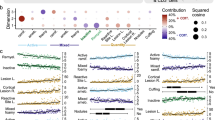Abstract
The unique sensitivity of magnetic resonance imaging (MRI) in detecting disease activity in multiple sclerosis (MS) and the objective nature of the information obtained suggest that MRI will be a useful and reliable way of monitoring treatment trials. There is a need to develop an appropriate database which would provide a standardised means of assessment, not only of MRI, but also of essential clinical information. As part of the program of Concerted Action in Multiple Sclerosis, funded by the Commission of the European Community (CEC), we have developed a database for recording serial brain MRI results. The database consists of core, entry and follow-up sections. Both entry and follow-up parts are subdivided into clinical, MR system and MRI data. We expect that the use of this database will maximise efficiency of MRI monitoring in MS treatment trials, particularly in multicentre studies.
Similar content being viewed by others
References
Miller DH, Barkhof F, Berry I, Kappos L, Scotti G, Thompson AJ (1991) Magnetic resonance imaging in monitoring the treatment of multiple sclerosis: Concerted Action guidelines. J Neurol Neurosurg Psychiatry 54:683–688
Poser CM, Paty DW, Scheinberg L, et al (1983) New diagnostic criteria for multiple sclerosis: guidelines for research protocols. Ann Neurol 13:227–231
Thompson AJ, Kermode AG, Wicks D, et al (1991) Major differences in the dynamics of primary and secondary progressive multiple sclerosis. Ann Neurol 29:53–62
Thompson AJ, Miller D, Youl B, et al (1992) Serial gadolinium enhanced MRI in relapsing remitting multiple sclerosis of varying disease duration. Neurology 42:60–63
Barkhof F, Hommes OR, Scheltens P, Valk J (1991) Quantitative MRI changes in gadolinium-DTPA enhancement after highdose intravenous methylprednisolone in multiple sclerosis. Neurology 41:1219–1222
Burham JA, Wright RR, Dreisbach J, Murray RS (1991) The effect of high-dose steroids on MRI gadolinium enhancement in acute demyelinating lesions. Neurology 41:1349–1354
Miller DH, Thompson AJ, Morrissey SP, et al (1992) High dose steroids in acute relapses of multiple sclerosis: MRI evidence for a possible mechanism of therapeutic effect. J Neurol Neurosurg Psychiatry 55 (in press)
Hawkins CP, Munro PMG, MacKenzie F, et al (1990) Duration and selectivity of blood-brain barrier breakdown in chronic relapsing experimental allergic encephalomyelitis studied by gadolinium-DTPA and protein markers. Brain 113: 365–378
Katz D, Taubenberger J, Raine C, McFarlin D, McFarland H (1990) Gadolinium-enhancing lesions on magnetic resonance imaging: neuropathological findings. Ann Neurol 28:243
Kuharik MA, Edwards MK, Farlow MR, et al (1988) Gd-enhanced MR imaging of acute and chronic experimental dymyelinating lesions. AJNR 9:643–648
Harris JO, Frank JA, Patronas N, McFarlan DE, McFarland HF (1991) Serial gadolinium-enhanced magnetic resonance imaging scans in patients with early, relapsing-remitting multiple sclerosis:implications for clinical trials. Ann Neurol 29:548–555
Bastianello S, Pozzili C, Bernardi S, et al (1990) Serial study of gadolinium-DTPA MRI enhancement in multiple sclerosis. Neurology 40:591–595
Miller DH, Rudge P, Johnson G, et al (1988) Serial gadolinium enhanced magnetic resonance imaging in multiple sclerosis. Brain 111:927–939
Grossman RI, Braffman BH, Brorson JR, Goldberg HI, Silberberg DH, González-Scarano F (1988) Multiple sclerosis: serial study of a gadolinium-enhanced MR imaging. Radiology 169: 117–122
Barkhof F, Scheltens P, Frequin STFM, Nauta JJP, Tas MW, Valk J, Hommes OR (1992) Relapsing-remitting multiple sclerosis: sequential enhanced MR imaging vs clinical findings in determining disease activity. AJR 159:1041–1047
Kermode AG, Thompson AJ, Tofts P, et al (1990) Breakdown of the blood-brain barrier precedes symptoms and other MRI signs of new lesions multiple sclerosis. Brain 113:1477–1489
Larsson HBW, Stubgaard M, Frederiksen JL, Jensen M, Henriksen O, Paulson OB (1990) Quantitation of blood-brain barrier defect by magnetic resonance imaging and gadolinium-DTPA in patients with multiple sclerosis and brain tumors. Magn Res Med 16:117–131
Paty DW (1991) Multiple sclerosis with an emphasis on MR imaging. In: Appel SH (ed) Current neurology. Mosby, St. Louis, pp 169–198
Wicks D, Tofts PS, Miller DH, et al (1992) Volume measurements of multiple sclerosis lesions with magnetic resonance imaging: a preliminary study. Neuroradiology 34:475–479
Truyen L, Gheuens J, Parizel PM, Van de Vyver FL, Martin JJ (1991) Long term follow-up of multiple sclerosis by standardized, non-contrast-enhanced magnetic resonance imaging. J Neurol Sci 106:35–40
Paty DW (1988) Trial measures in multiple sclerosis: the use of magnetic resonance imaging in the evaluation of clinical trials. Neurology 38 [Suppl 2]:82–83
Paty DW, Oger JJF, Kastrukoff LF, et al (1988) MRI in the diagnosis of MS: a prospective study with comparison of clinical evaluation, evoked potentials, oligoclonal banding, and CT. Neurology 38:180–185
Uhlenbrock D, Seidel D, Gehlen W, et al (1988) MR imaging in multiple sclerosis: comparison with clinical, CSF, and visual evoked potentials. AJNR 9:59–67
Ormerod IEC, Miller DH, McDonald WI, et al (1987) The role of NMR imaging in the assessment of multiple sclerosis and isolated neurological syndromes: a quantitative study. Brain 110: 1579–1616
Isaac C, Li DKB, Genton M, et al (1988) Multiple sclerosis: a serial study using MRI in relapsing patients. Neurology 38: 1511–1515
Willoughby EW, Grochowski E, Li DKB, et al (1989) Serial magnetic resonance scanning in multiple sclerosis: a second prospective study in relapsing patients. Ann Neurol 25:43–49
Koopmans RA, Li DKB, Oger JJF, et al (1989) Chronic progressive multiple sclerosis: serial magnetic resonance brain imaging over six months. Ann Neurol 26:248–256
Kappos L, Städt D, Ratzka M, et al (1988) Magnetic resonance imaging in the evaluation of treatment in multiple sclerosis. Neuroradiology 30:299–302
Kurtzke JF (1983) Rating neurological impairment in multiple sclerosis: an expanded disability status scale (EDSS). Neurology 33:1444–1452
Francis DA, Bain P, Swan AV, Hughes RAC (1991) An assessment of disability rating scales used in multiple sclerosis. Arch Neurol 48:299–301
Noseworthy JH, Vandervoort MK, Wong CJ, Ebers GC and the Canadian Cooperative MS Study Group (1990) Interrater variability with the Expanded Disability Status Scale (EDSS) and Functional Systems (FS) in a multiple sclerosis clinical trial. Neurology 40:971–975
Author information
Authors and Affiliations
Rights and permissions
About this article
Cite this article
Barkhof, F., Thompson, A.J., Kappos, L. et al. Database for serial magnetic resonance imaging in multiple sclerosis. Neuroradiology 35, 362–366 (1993). https://doi.org/10.1007/BF00588371
Received:
Issue Date:
DOI: https://doi.org/10.1007/BF00588371




